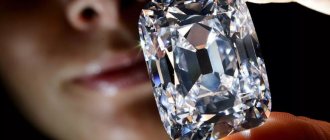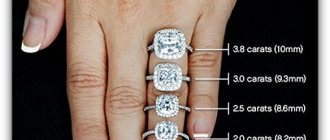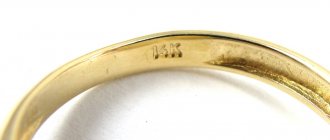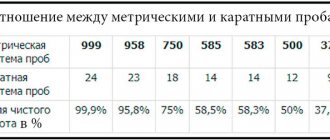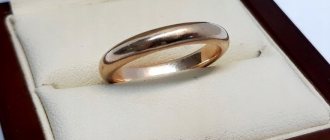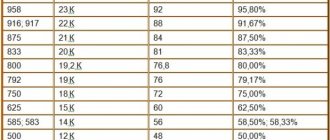Precious stones are not only the pride of their owners, they are also an excellent way to invest and store money. However, stones come in such small sizes that a special measurement was invented for them - the carat.
But the mass of a precious mineral is expressed in carats, and how much is it? Stone connoisseurs can easily figure this out, but what does the common man think when he hears about a 2-carat diamond? What kind of stone is this, how much does it weigh and what is its cost? Let's look at this issue in detail.
The history of measuring the weight of minerals and precious metals and what is the cost of one carat
The first weighing methods appeared 4 thousand years ago. Ancient civilizations needed measurements to develop agriculture, trade, crafts and construction. Each ancient society had its own way of measuring weight until they arrived at a common system.
In ancient Rome, gems were weighed using coral tree seeds. One seed weighed as much as a small diamond. The weight of the coins was measured using acacia seeds.
It was from the name of this plant in Latin (Ceratonia siliqua) that the word “carat” appeared. In the modern world, it is equal to 200 mg, like one acacia seed.
In northern Europe, barley grains were used to measure minerals.
Carat does not have a single cost table : much depends on the chosen precious metal or stone, as well as on its quality and deposit. For example, the price of a gem such as a ruby for 1 carat in rubles is from 12,000 and above. But the price of sapphire for 1 carat starts from 17,000 rubles.
What were the carats?
For a long period of time, there was no unified weighing system for precious stones or metals in the world. Each part of the world had its own variations. In the Netherlands and England it differed by only a couple of milligrams, but in Italy it was already several tens of mg!
One reason for this variation was that small traders were inconvenient to purchase new weighing machines.
The policy of England also interfered, where everything was measured in pounds and ounces, while Europe weighed in kilograms and grams.
But the Committee of Measurements in France in 1907 recorded how much a carat weighs - 200 mg. This measure has been officially adopted throughout the world since the 20s of the 20th century.
What is carat
It is a measure of weight outside the metric system. Jewelers designate it as ct, and the carats of all jewelry stones are ct TW. They are considered together if they belong to the same type of gems. For example, the weight of rubies in earrings is indicated by one number, but if other stones are present, their weight will be indicated separately.
Difference between gold and diamond carats
Gold is the amount of gold in a precious metal without impurities. The measure depends on the sample, which expresses the percentage of pure metal in the alloy.
A jewelry carat is the weight of a whole crystal. Unlike gold, the quality of which depends on the purity, for semi-precious stones this is a separate value. Therefore, precious stones are evaluated according to several criteria: clarity, color, cut.
Why is this parameter important?
The weight of a precious metal plays a big role in its valuation. In nature, large stones are rare, so the greater the weight, the more expensive the product with the gem will cost. But this is only the first step in estimating the cost of stones.
Next come clarity, color and cut quality, so a 0.33 ct diamond may be more expensive than a 0.65 ct diamond if it has higher characteristics.
Attention! Stones with a large number of carats are very valuable and are sold at auction.
History of karat
The carat is not an element of the system of weights and measures, which is why it is called non-systemic. The name comes from the carob tree Ceratonia siliqua. This is an evergreen tree that has long been common in the Mediterranean. It produced fruits - pods that always corresponded to one another in weight and volume. Noticing this feature, people began to use its pods as a weight standard since biblical times. During the Roman Empire, the mature dry pods were introduced into the system of measurements; one unit equaled 0.19 grams and was called siliqua. Carat is only the Greek version of this name, which came into use later.
There are many varieties of karat, which are similar in essence, but have different numerical equivalents. A metric carat is 0.2 grams. In the Middle East and North Africa, the qirat was used - the so-called Arabic carat, which was measured in milligrams and had an approximate value (from 195 to 223 mg). An English carat is also an indicator in milligrams; it is equal to 205 mg. Egypt has always had its own standards for measurements. Their carat is measured in fractions of faddan and qadah, and was approximately 0.064 l or just over 175 sq. meters. These measures do not apply to precious metals and stones.
Golden terminology
But for gold and silver, carat does not mean the mass as a whole, but the weight of the pure metal. Fineness is the purity of a precious metal; it is measured by the amount of gold without impurities. That is, 583 purity is 58.3% gold in the metal. The number of carats will depend on the sample of the precious metal.
If you are assured that a chain or bracelet is made of 32 carat gold, do not be deceived. For a precious metal, the highest unit is 24 karat gold, how much is it in the metric system? They correspond to the highest standard - 999. There cannot be a hundred percent standard, because natural metal always has impurities. And even after the most thorough cleaning, aka refining, one hundredth of foreign substances remain.
The color of the metal also depends on the number of carats. Gold with the highest parameter (24) has a bright yellow color. Previously, the purity of gold was checked by heating: if the metal turned red, then it was considered pure.
Metal with fewer carats has a greenish or red tint depending on the type of impurity. For example, 18 carat gold, what standard corresponds to - 750.
Accordingly, metal prices will differ depending on the number of carats. One gram of 24 measures will cost approximately 3,000 rubles, but a gram of 14 measures can be purchased for around 1,500 rubles.
In Russia and Europe, different valuation systems for precious metals are used. In our country they use the metric system, and in Europe they use the carat system.
To convert a carat standard to a metric standard, you need to multiply the carat standard by 100 and divide by 24. Therefore, for example, 22 carat gold cannot be officially found in Russia. But you can find 916 gold.
How to determine the carat of a diamond without a scale?
Precise microscales are a useful thing, but not cheap, and branded models approved by jewelry manufacturers are profitable to buy exclusively for stores. Therefore, it is much easier to calculate the declared mass using the formula named after the legendary French merchant Jean-Baptiste Tavernier. Back in the 17th century, he managed to calculate the direct mathematical relationship between the size of a cut diamond and its specific gravity.
The formula looks like this:
M = (d*d) * h * 0.0061
The letter d denotes the diameter, h the height, and the last factor is the proportion coefficient of the stone; it remains conditionally constant. The only practical difficulty is to measure the dimensions with an accuracy of at least one tenth of a millimeter, otherwise the calculation makes no sense.
Important: The error of the Tavernier formula is 10-15%, depending on the deviations of the measuring instruments. That is why future owners of jewelry are advised to buy an engineering ruler in advance with the lowest possible division price.
However, the difficulties do not end here. The fact is that during the life of the eminent jeweler who supplied gems to the court of Louis XIV, they knew how to give diamonds an exclusively round shape; accordingly, for others a modified calculation will be required.
How many grams are in one carat of jewelry?
You can determine the weight of a gem yourself; there are several ways to do this.
Diameter to weight ratio
You can find out the weight by diameter if you are dealing with round gems. A special table shows the ratio of the mass of the stone and its diameter. For example, 1 carat is how much in diameter:
- 1 millimeter – 0.005 carats;
- 2 mm – 0.003;
- 3 mm – 0.1;
- 4 mm – 0.25;
- 5 mm – 0.5.
The larger the diameter of the gem, the higher its mass. Here you should also take into account the type of cut, since an oval cut will require less material than a classic round cut.
Calculation of gem weight relative to cut
In the absence of scales, minerals are measured using their length, width and cut. Here are some excerpts from the table for determining weight by cut:
- Round. The squared diameter is multiplied by the height of the stone, by its density and a coefficient of 0.0018.
- Marquis. Length multiplied by width, height, density and a factor of 0.0016.
- Round cabochon. The diameter is multiplied by the density of the stone and a coefficient of 0.00259.
Attention! When using this method, you must always take into account possible defects and add 3-6% of the resulting mass to the convexity of the stone.
Diamond carats and prices.
When looking at prices, you should keep in mind that larger diamonds are much rarer than smaller ones of the same quality.
This is why when stones within a given quality range increase in size, their prices increase even more.
For example, a 2 CT diamond does not cost twice as much as a one-carat stone of the same quality, but its actual price may be more than three or four times more.
Remember to compare diamonds with similar characteristics. Differences in weight between two stones will not matter if their cut, color and clarity are significantly different.
Diamond weight
A girl's best friend is diamonds! Cut diamonds are popular all over the world. There are many tables for determining their weight without special measuring instruments.
How to determine how much a diamond weighs if you know the size in mm
The weight of diamonds, like other cut stones, is calculated using tables. To measure them, they do not use ordinary rulers, but special ones, with divisions in fractions of millimeters.
Since often a gem does not fit exactly 2 or 4 millimeters in size, it can have a dimension of 2.1 and so on.
The type of cut is also taken into account when calculating the weight of the stone:
- For a round cut, multiply the height of the diamond by the diameter of the girdle squared and by a factor of 0.006.
- For a heart cut, the length is multiplied by height, width, length and a factor of 0.0059.
- For the pear cut, the formula is similar to the heart cut.
The coefficient changes, and it depends on the ratio of the length and width of the processed stone. To simplify counting, there are various tables that will help the owner quickly calculate the approximate weight of a diamond.
One carat diamonds
Such a diamond is considered a large stone. So, 1 carat is how many grams? 200 mg is a generally accepted value. For a processed diamond, a weight of 200 mg is considered so significant that 1 carat of diamond (price in rubles) can reach 25 million. A 1 carat diamond, the price of which is significantly lower, may turn out to be of poor quality or counterfeit.
A low quality diamond can be bought for 60,000 rubles; the better the quality, the higher the cost. Diamonds over 1 carat are considered premium stones.
The cost of a diamond can also be affected by its shade; the most popular stones are transparent, without color impurities. Do not forget that 1 carat of diamond does not guarantee the same value for all diamonds, since there are other criteria.
What is 1 carat diamond:
Diamond weight table
What is a carat of a diamond? As with other gems, this is a measure of weight. Diamond carats table:
Diameter to weight ratio
But is it possible to determine the mass of a stone based only on its diameter? If this applies to round stones, then yes. Thanks to their shape, you can determine their weight in grams by measuring their diameter. There is a special table that shows all the data regarding the weight of the stone and the specific size. We will provide only some information on this issue. For round stones there is the following weight estimate:
- One millimeter is five thousandths of a karat.
- Two millimeters – three hundredths of a car.
- Three millimeters is one tenth of a carat.
- Four millimeters – twenty-five hundredths of a karat.
- Five millimeters is half a car.
- Six millimeters – eight tenths of a carat.
- Six and a half millimeters - one carat.
As the diameter of the girdle increases, its weight will naturally increase. Although the weight depends on the diameter, with different cuts it will be different for the same type of gemstone. Thus, with a “princess” or “oval” cut, the consumption of waste material will be less than with a round cut, so they are more profitable from a material point of view. It also requires less effort from the jeweler.
How to compare stone prices
There are criteria for determining the cost of a stone:
- Shade and color. Color intensity can greatly influence the price of a gem. Stones that are too dark or light will be lower in price; admixtures of different colors also reduce the cost. The most valuable stones will be those with deep, bright shades.
- Processing (cut, shape). The type of cut reveals the stone's ability to play with light. The better the work is done, the more the gem will shine and the more valuable it will be.
- Transparency. Natural stones are rarely completely free of defects; the most transparent ones are an exception and are sold at auctions at high prices.
- Size and weight. This criterion affects stones of good quality more; for low-grade gems, size matters much less. The size may be different for stones of the same weight, but it is the mass that plays a big role. The cost of a good diamond of 0.25 carats will be about 160,000 rubles, and 0.5 ct – already about 300,000 rubles.
Attention! Expensive stones must have a quality certificate.
Why are gemstones measured in carats?
Important questions to ask when purchasing.
If you are purchasing diamond jewelry with a center stone (the largest diamond), you should ask about the individual carat value of that stone.
The center stone is the most visible and is usually the highest quality compared to the smaller diamonds in the setting.
This is why the center stone will often be the highest value diamond, and knowing its carat size will allow you to figure out if you're getting a good deal.
The next question you should ask is: what are the carats of the smaller diamonds in the ring (called "diamond accents")?
These stones are often of lower quality because they are not as visible as the center diamond. Knowing the carat of the center stone and diamond accents will allow you to compare different pieces of jewelry and find the best price.
For example, a ring with ten small diamonds and a 2ct CTW is not comparable to a ring that has the same 2ct CTW, but with one large diamond and two smaller ones. Typically, large diamonds cost disproportionately more than smaller ones of similar quality.
Additionally, the larger diamond in the second ring will likely have a better color, cut, and clarity as the center stone than each of the ten smaller ones in the first ring.
If this is indeed the case, then you should not pay the same price for the first ring just because it has the same carats (assuming all other characteristics of both rings, such as metals and settings, are comparable).
In general, when you see the total carat on a jewelry label, always ask for a breakdown of that value for individual stones if that information is not listed.



